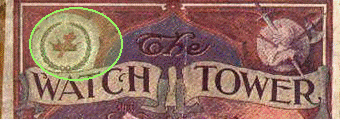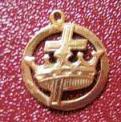United Religions Initiative (a One World Demand)
Another false belief that the URI promotes is religious relativism, the notion that all religions are equally true and are equally paths to God. In a July 1998 interview with a journalist from the official newspaper for the Lambeth conference (a once-a-decade worldwide gathering of Anglican bishops), Bishop Swing said, "The question is can we stand the generosity of God in that he reveals himself to other people in the world through other symbols and through other stories?"(15) This reduces the historical events of the Incarnation, the Crucifixion, and the Resurrection of Christ to the level of "symbols" and "stories," allowing Bishop Swing to equate non-Christian myths to the saving, historical acts of Christ's ministry.
Yet another false belief that the URI fosters is the notion that, as Anglican Bishop Ottley (a URI supporter) says, "the world's agenda is the agenda of the church." (16) Bishop Swing - like other URI supporters - says that a United Religions is what the world demands of believers: "There is going to come a time when the world is just going to insist that religions grow up and begin to talk to each other for the sake of global good and global harmony."(17) The root of the problem may be that URI leaders hold a worldly view of what religion is. URI Vice President William Rankin said, "J. M. Yinger defines religion as 'a system of beliefs and practices by means of which a group of people struggles with ultimate problems of human life. It expresses their refusal to capitulate to death, to give up in the face of frustration, to allow hostility to tear apart their human aspirations.' So far, so good."(18) Yinger's definition reduces religion to psychology and social action - and Rankin does not go beyond it to a God-centered view of religion.
An earth-bound definition of religion is the only way that Bishop Swing could argue that "The United Religions will not be a rejection of ancient religion but will be found buried in the depths of these religions."(19) If, indeed, United Religions were to be found "buried in the depths" of the Christian Faith, countless early martyrs could have avoided agonizing deaths by burning incense in front of the statue of the Roman Emperor, and today's martyrs in Sudan and China could apostatize with a calm conscience. Maybe martyrs are passé, anyhow; URI Vice President Rankin says that "The United Religions Initiative exists to bring people together from all the religions of the world, to create a world where no one has to die because of God, or for God, any more."(20)
The leaders of the URI do not place their ultimate hope in God or in the saving acts of Christ; they hope for an earthly utopia that the United Religions will help bring into being. In the letter that formally invited delegates to the summer 1997 URI summit conference, Bishop Swing wrote that United Religions would be "a deep new source of hope and healing for people and the earth itself."
Bishop Swing told the 1997 URI summit conference: "If you have come here because a spirit of colossal energy is being born in the loins of earth, then come here and be a midwife. Assist, in awe, at the birth of new hope."(22) The "new hope" will have the Earth - and not the Virgin Mary - as its mother. The Catholic Church speaks for all orthodox Christians in rejecting such fantasies of a man-made paradise: "The Antichrist's deception already begins to take shape in the world every time the claim is made to realize within history that messianic hope which can be only realized beyond history through the eschatological judgment. The Church has rejected even modified forms of this falsification of the kingdom to come under the name of millenarianism, especially the 'intrinsically perverse' political form of a secular messianism."(23)
The URI made a fateful choice in 1996, expanding its scope beyond the traditional religions to embrace what its leaders call "new spiritual movements" - and what the rest of us call the New Age movement. Bishop Swing still stands by this choice; he told the Commonwealth Club of San Francisco in May 1999 that the three principles agreed upon by the founders of the URI in 1996 were: "1. we will be a grass roots movement; 2. it has to be men and women together; 3. invite religions and spiritual movements together - right from the beginning."(24) Bishop Swing says that the URI will remain open to new spiritual movements and "cults": "Asked how the URI would handle cults, Bishop Swing answered that the United Religions would probably look a little like Alcoholics Anonymous" 'very diffuse.' He added that 'In United Religions, if you can abide by the purpose and principle, then you can get together. Once you open the door, you have to keep it open.' "(25) Several New Age leaders, including Robert Muller, Neale Donald Walsch, and Barbara Marx Hubbard, are active and enthusiastic supporters of the URI.
Muller, Marx Hubbard, and Walsch support world government and a socialist economy, believe that the Fall was really an ascent into knowledge for humanity, and expect an imminent, apocalyptic social transformation that will lead humanity into the New Age. The problem is not a few "smoking gun" quotes pulled from otherwise-innocent writings; these New Age leaders have provided an arsenal full of smoking guns, all pointed in the same direction. These New Age teachers - and their theosophical mentors - propose a comprehensive anti-Gospel, a modern revival of the Gnostic heresy, and an inversion of Christian morality.
The New Age leaders directly associated with the URI - Muller, Walsch, and Marx Hubbard - draw inspiration from Theosophy, an occult movement started in 1875 by Helena Petrovna Blavatsky. Theosophy has since had significant influence on the New Age movement in the US and worldwide. Its teachings include praising Lucifer as the bringer of light to humanity, denouncing orthodox Christianity and Judaism as "separative" and "obsolete," and forecasting a coming age of enlightened, spiritual collectivism - after the cleansing of earth to remove the people who do not accept progress.
http://fatima.freehosting.net/Articles/Summary2.htm
(Commentary: There is newer information on UR! but a particular website I was looking for is MIA.
UR! is connected to Un.
I would like to find a connection between UR! and the purpose of that "library card" as I suspect a posssible link.
But first, I would like to expound further on the principles of this directive and how it has already been established to fall into place.
This link gives a very short summary of the interfaith creed. http://fatima.freehosting.net/Articles/Art15.htm
excerpt:
10. Believing that one's own faith is true and that others are not (or reveal less truth than one's own) is a mark of intolerance and "fundamentalism."
12. Preservation of the biosphere (along the lines set out by the environmental movement) is the most important human value, and is of greater importance than human life or human rights.
Tradition, law, individual freedom, and property rights must not interfere with achieving these goals.
14. Tolerance, however, has its limits. As URI Board Secretary Paul Chafee said, "We can't afford fundamentalists in a world this small." (1)



